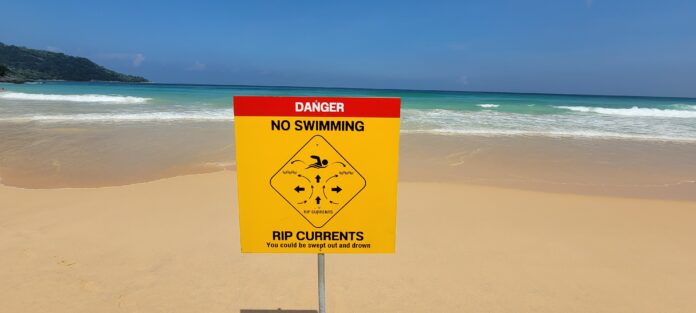Rip currents are powerful, narrow channels of fast-moving water that flow away from the shore, posing a serious risk to swimmers. Understanding the dangers associated with rip currents and how to respond can be crucial for ensuring safety while enjoying the beach. Here’s an in-depth look at why swimming in rip currents is dangerous and how you can protect yourself, along with notable accidents that highlight the serious risks involved.
What Is a Rip Current? Rip currents are formed when waves break strongly in some areas and weakly in others, creating a flow of water that rushes back out to sea through the gap in the breaking waves. These currents can be incredibly strong, moving at speeds of up to 8 feet per second (2.4 meters per second), which is faster than most swimmers can swim.
The Dangers of Rip Currents
1. Strong and Unpredictable Force: Rip currents can pull swimmers away from the shore with considerable force. This sudden and unexpected pull can quickly exhaust even experienced swimmers, leading to dangerous situations where they may become disoriented or fatigued.
2. Difficulty in Escape: Contrary to popular belief, attempting to swim directly back to the shore against a rip current is not effective and can be counterproductive. The current’s strength can overpower even the most skilled swimmers, increasing the risk of drowning.
Notable Accidents Involving Rip Currents
**1. Florida Rip Current Tragedy (2020) In July 2020, a tragic incident occurred at Daytona Beach, Florida, where two tourists were swept away by a rip current. Despite the efforts of lifeguards and rescuers, both individuals drowned. The accident highlighted the unpredictability of rip currents and the importance of heeding local warnings.
**2. Australia’s Deadly Rip Current (2018) In December 2018, a strong rip current claimed the life of a swimmer at Bondi Beach, Australia. The swimmer, unfamiliar with the dangers of rip currents, was pulled far from the shore. Despite a prompt rescue attempt, the swimmer did not survive. The incident led to increased awareness campaigns about rip current safety.
**3. Hawaii Beach Incident (2015) A series of accidents related to rip currents occurred in Waikiki Beach, Hawaii, in 2015. Over a weekend, multiple swimmers were rescued from rip currents, with one fatality reported. The events underscored the need for vigilance and the importance of swimming in designated safe areas.
**4. California Rip Current Rescue (2013) In August 2013, a dramatic rescue took place at Huntington Beach, California, where a family of four was caught in a rip current. The swift action of lifeguards was crucial in saving the family members. The incident was a stark reminder of the power of rip currents and the critical role of lifeguards in beach safety.
**5. South Africa Rip Current Fatality (2011) In 2011, a tragic rip current incident occurred at Durban’s North Beach in South Africa. A swimmer was swept out to sea by a powerful rip current and drowned despite the efforts of local rescuers. The incident led to increased beach safety measures and public education about rip currents.
What to Do if Caught in a Rip Current:
- Stay Calm: Panic can quickly lead to exhaustion. Focus on staying afloat and conserving energy.
- Float and Signal for Help: If you can, float on your back and signal for help by raising one arm.
- Swim Parallel to the Shore: Instead of trying to swim directly back to the shore, swim parallel to the shoreline to escape the narrow current. Once out of the current, swim at an angle back to the shore.
